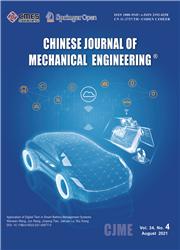复杂型材冷轧过程中硬度与变形的关系
IF 4.5
2区 工程技术
Q1 Engineering
引用次数: 0
摘要
摘要对冷轧加工的螺纹、花键等复杂型材进行表面硬化处理,可有效提高被轧件的力学性能和表面质量。表层硬度分布与轧制变形密切相关。建立合适的关联模型来描述复杂型材冷轧成形过程中应变与硬度之间的关系,有助于优化轧制参数和改进轧制工艺。本研究提取并设计了反映复杂型材轧制过程中不均匀变形的物理模拟实验,获得了反映复杂型材轧制局部变形特征的训练样本大数据集(超过400个数据点)。采用多种多项式和幂函数进行回归分析,并通过单道次、多道次物理模拟试验和复杂型材轧制试验对45#钢的回归相关模型进行了评价。结果表明,多项式回归模型在应变范围($$\varepsilon < 1.2$$ ε &lt;1.2),应变范围外应变与硬度的相关关系(即$$\varepsilon > 1.2$$ ε &gt;1.2)训练样本的方差可以用幂回归模型很好地描述;因此,45#钢复杂型材轧制过程中应变与硬度的相关关系可以用三阶多项式($$\varepsilon < 1.2$$ ε &lt;1.2和幂函数,拟合常数在$$\varepsilon > 1.2$$ ε &gt范围内;1.2;采用分段函数对回归模型的预测误差小于10%.本文章由计算机程序翻译,如有差异,请以英文原文为准。
Relationship between Hardness and Deformation during Cold Rolling Process of Complex Profiles
Abstract The hardening on surface of complex profiles such as thread and spline manufactured by cold rolling can effectively improve the mechanical properties and surface quality of rolled parts. The distribution of hardness in superficial layer is closely related to the deformation by rolling. To establish the suitable correlation model for describing the relationship between strain and hardness during cold rolling forming process of complex profiles is helpful to the optimization of rolling parameters and improvement of rolling process. In this study, a physical analog experiment reflecting the uneven deformation during complex-profile rolling process has been extracted and designed, and then the large date set (more than 400 data points) of training samples reflecting the local deformation characteristics of complex-profile rolling have been obtained. Several types of polynomials and power functions were adopted in regression analysis, and the regression correlation models of 45# steel were evaluated by the single-pass and multi-pass physical analog experiments and the complex-profile rolling experiment. The results indicated that the predicting accuracy of polynomial regression model is better in the strain range (i.e., $$\varepsilon < 1.2$$ ε < 1.2 ) of training samples, and the correlation relationship between strain and hardness out strain range (i.e., $$\varepsilon > 1.2$$ ε > 1.2 ) of training samples can be well described by power regression model; so the correlation relationship between strain and hardness during complex-profile rolling process of 45# steel can be characterized by a segmented function such as third-order polynomial in the range $$\varepsilon < 1.2$$ ε < 1.2 and power function with a fitting constant in the range $$\varepsilon > 1.2$$ ε > 1.2 ; and the predicting error of the regression model by segmented function is less than 10%.
求助全文
通过发布文献求助,成功后即可免费获取论文全文。
去求助
来源期刊

Chinese Journal of Mechanical Engineering
ENGINEERING, MECHANICAL-
CiteScore
5.60
自引率
4.80%
发文量
3097
审稿时长
8 months
期刊介绍:
Chinese Journal of Mechanical Engineering (CJME) was launched in 1988. It is a peer-reviewed journal under the govern of China Association for Science and Technology (CAST) and sponsored by Chinese Mechanical Engineering Society (CMES).
The publishing scopes of CJME follow with:
Mechanism and Robotics, including but not limited to
-- Innovative Mechanism Design
-- Mechanical Transmission
-- Robot Structure Design and Control
-- Applications for Robotics (e.g., Industrial Robot, Medical Robot, Service Robot…)
-- Tri-Co Robotics
Intelligent Manufacturing Technology, including but not limited to
-- Innovative Industrial Design
-- Intelligent Machining Process
-- Artificial Intelligence
-- Micro- and Nano-manufacturing
-- Material Increasing Manufacturing
-- Intelligent Monitoring Technology
-- Machine Fault Diagnostics and Prognostics
Advanced Transportation Equipment, including but not limited to
-- New Energy Vehicle Technology
-- Unmanned Vehicle
-- Advanced Rail Transportation
-- Intelligent Transport System
Ocean Engineering Equipment, including but not limited to
--Equipment for Deep-sea Exploration
-- Autonomous Underwater Vehicle
Smart Material, including but not limited to
--Special Metal Functional Materials
--Advanced Composite Materials
--Material Forming Technology.
 求助内容:
求助内容: 应助结果提醒方式:
应助结果提醒方式:


